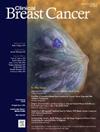Long-Term Safety and Efficacy of the Fixed-Dose Combination of Pertuzumab and Trastuzumab for Subcutaneous Injection in Patients With HER2-Positive Early Breast Cancer in PHranceSCa, a Randomized, Open-Label Phase II Study
IF 2.5
3区 医学
Q2 ONCOLOGY
引用次数: 0
Abstract
Background
We assessed long-term safety, efficacy, and health-related quality of life during the continuation phase after 3 years’ follow-up in PHranceSCa (NCT03674112).
Patients and Methods
This was a randomized, open-label, international, multicenter, crossover, Phase II study in adjuvant HER2-positive early breast cancer. One hundred fifty nine patients received 3 cycles of the fixed-dose combination of pertuzumab and trastuzumab for subcutaneous injection (PH FDC SC), then 3 of intravenous pertuzumab and trastuzumab (P + H IV), or vice versa. Postcrossover, patients continued preferred treatment (≤ 18 cycles total).
Results
Most adverse events, including all cardiac events (n = 2) and anaphylaxis/hypersensitivity (n = 3) were grade 1/2. None were grade 4/5. Grade 1/2 local injection-site reactions occurred in 13 patients (9.4%) receiving PH FDC SC. Other events occurred at comparable rates between arms. The overall event-free rate for invasive disease-free survival was 94.17% (95% confidence interval, 90.47-97.87) at 3 years; overall survival was 98.71% (96.92-100). Meaningful changes from baseline in health-related quality of life included improvements in role and social functioning, and reductions in financial difficulty.
Conclusion
PH FDC SC was well tolerated, with safety consistent with that of P + H IV (except local injection-site reactions) and no grade ≥ 3 anaphylaxis/hypersensitivity or new safety signals in the continuation period. Immature efficacy data showed high event-free rates, consistent with the known clinical benefit of pertuzumab and trastuzumab (although follow-up was relatively short at 3 years). PHranceSCa adds to the totality of evidence reinforcing the long-term clinical benefit and safety of pertuzumab and trastuzumab.
一项随机、开放标签的PHranceSCa II期研究:Pertuzumab和曲妥珠单抗固定剂量联合皮下注射治疗her2阳性早期乳腺癌患者的长期安全性和有效性
背景:我们在PHranceSCa (NCT03674112)的3年随访后评估了延续期的长期安全性、有效性和健康相关生活质量。患者和方法:这是一项随机、开放标签、国际、多中心、交叉、辅助her2阳性早期乳腺癌的II期研究。159例患者接受了3个周期的帕妥珠单抗和曲妥珠单抗皮下注射固定剂量联合(PH FDC SC),然后3个周期的静脉注射帕妥珠单抗和曲妥珠单抗(P + H IV),反之则相反。交叉后,患者继续首选治疗(总周期≤18个周期)。结果:大多数不良事件,包括所有心脏事件(n = 2)和过敏反应/超敏反应(n = 3)均为1/2级。没有一个是4/5级。接受PH FDC SC治疗的13例患者(9.4%)发生了1/2级局部注射部位反应,其他事件在两组之间的发生率相当。3年侵袭性无疾病生存的总体无事件率为94.17%(95%可信区间,90.47-97.87);总生存率为98.71%(96.92-100)。与健康相关的生活质量基线相比,有意义的变化包括角色和社会功能的改善,以及财务困难的减少。结论:PH FDC SC耐受性良好,安全性与P + H IV一致(局部注射部位反应除外),持续期内无≥3级过敏反应/超敏反应或新的安全信号。未成熟的疗效数据显示高无事件率,与已知的帕妥珠单抗和曲妥珠单抗的临床获益一致(尽管随访时间相对较短,为3年)。PHranceSCa增加了强化帕妥珠单抗和曲妥珠单抗长期临床获益和安全性的证据。
本文章由计算机程序翻译,如有差异,请以英文原文为准。
求助全文
约1分钟内获得全文
求助全文
来源期刊

Clinical breast cancer
医学-肿瘤学
CiteScore
5.40
自引率
3.20%
发文量
174
审稿时长
48 days
期刊介绍:
Clinical Breast Cancer is a peer-reviewed bimonthly journal that publishes original articles describing various aspects of clinical and translational research of breast cancer. Clinical Breast Cancer is devoted to articles on detection, diagnosis, prevention, and treatment of breast cancer. The main emphasis is on recent scientific developments in all areas related to breast cancer. Specific areas of interest include clinical research reports from various therapeutic modalities, cancer genetics, drug sensitivity and resistance, novel imaging, tumor genomics, biomarkers, and chemoprevention strategies.
 求助内容:
求助内容: 应助结果提醒方式:
应助结果提醒方式:


